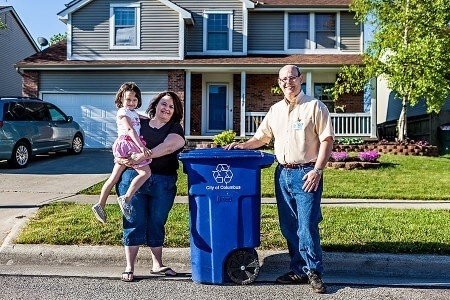
Environmental Features Incoprorated into Hilliard’s New Residential Solid Waste Contract
April 28, 2014Get Green — and Save Green — with a Well-Planned Landscape
June 16, 2014Paper vs. Plastic
You’re at the store, paying for a purchase, and are asked, “Would you like paper or plastic?” It’s a question that we hear almost on a daily basis and most of us don’t even think twice. But, for some people, it’s a stressful decision. Convenience is pulling you toward plastic, but your green conscience might turn you toward paper. Let’s take a closer look at which of these two items is truly the best choice for the environment.
Plastic
When plastic grocery bags were first introduced in the 1970’s, they were touted as lightweight, durable, and low cost. Over time, consumers grew attached to the plastic bag’s secondary uses — from carrying your lunch to cleaning up after the dog. The conveniences of these little bags have made it the most frequently used grocery bag in the U.S. Hundreds of millions are dispensed each year, creating a modern menace that often winds up caught in trees, blowing down the road, and drifting in oceans. Even “biodegradable plastic” is misleading, because wood fiber has been mixed with the plastic. When buried, the wood dissolves leaving a million tiny pieces of plastic instead of one bag. Once plastic reaches a landfill, it will never go away.
However, when it comes to plastic, it is not all doom and gloom. One of plastic’s greatest assets is its recyclability. To recycle almost any kind of plastic is to merely re-melt and re-form. The re-melting will sterilize, allowing any recycled plastic to be used in even hospital-grade products. And plastic can be re-formed into anything, many times over before it becomes brittle. If society were to implement a strict plastic recycling policy, an enormous percentage of plastic could efficiently be used again.
Paper
So, how do paper bags compare? You might be surprised! Despite the fact that paper is biodegradable, the many environmental disadvantages of the production of paper bags might outweigh the benefits. The first disadvantage is pollution. Paper production emits air pollution – specifically, 70 percent more pollution than the production of plastic bags [source: Thompson]. And consider that making paper uses trees that could instead be absorbing carbon dioxide.
The second disadvantage is energy waste. Even though petroleum goes into making plastic, it turns out that making a paper bag consumes four times as much energy as making a plastic bag [source: reusablebags.com].
Third, water waste. The production of paper bags uses three times the amount of water it takes to make plastic bags [source: Lilienfield].
If both paper and plastic are bad news, what should you use? Most studies agree that the most beneficial choice for the environment is a reusable bag. According to a 2004 study by the French retailer Carrefour, a reusable bag is better for the environment regardless of what it is made from, as long as it is used at least four times.
So next time you are at the store and get to choose between paper and plastic, don’t let green guilt necessarily pull you toward paper. Consider that both materials have drawbacks for the environment and consider bringing a reusable bag. It’s the small things that can make a big difference.




